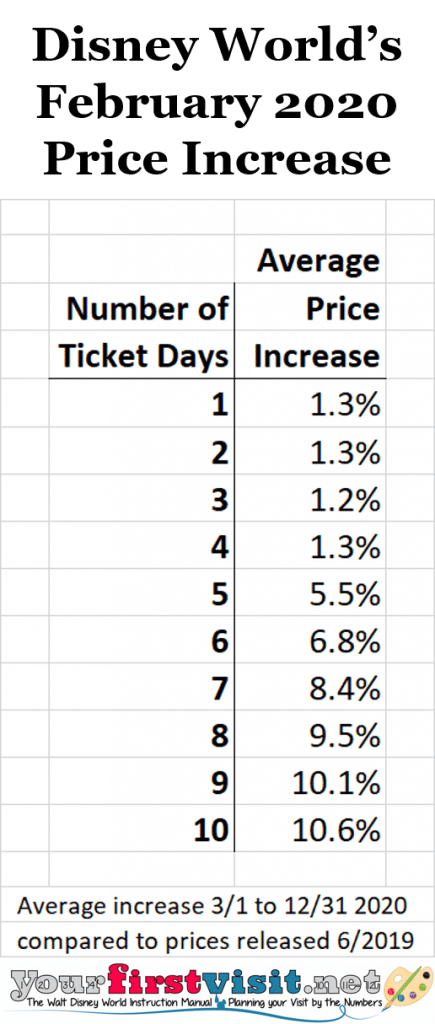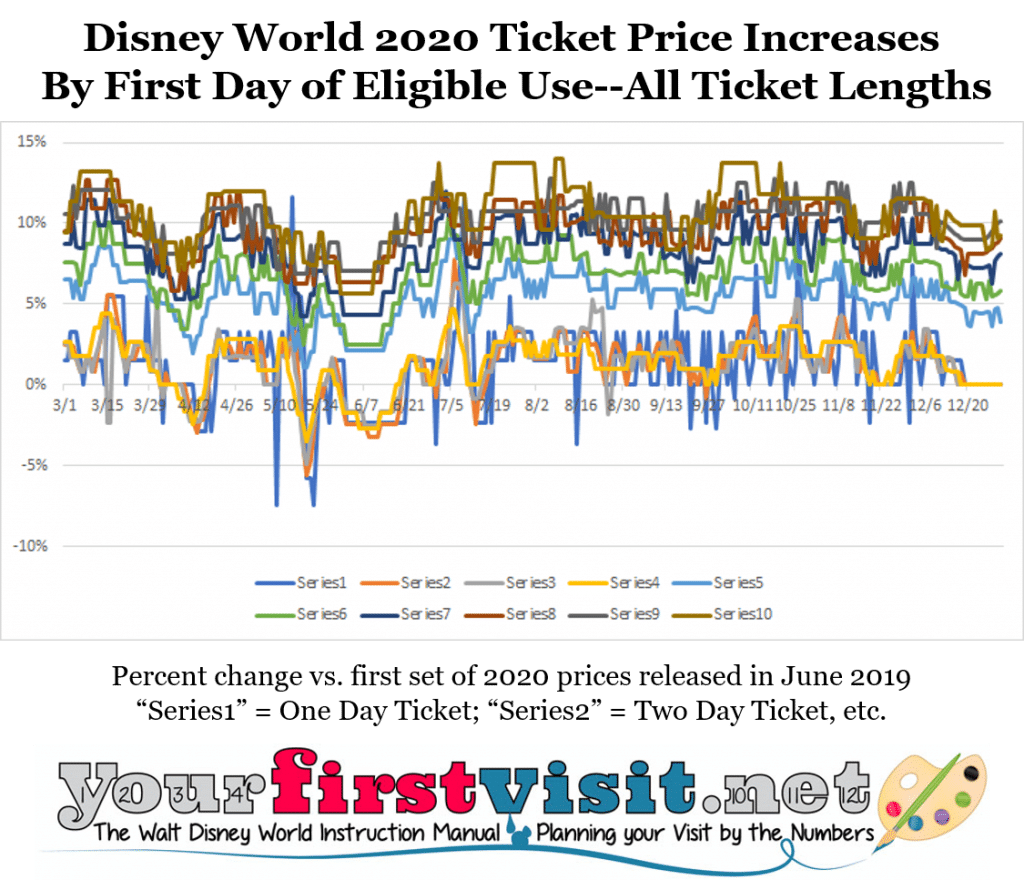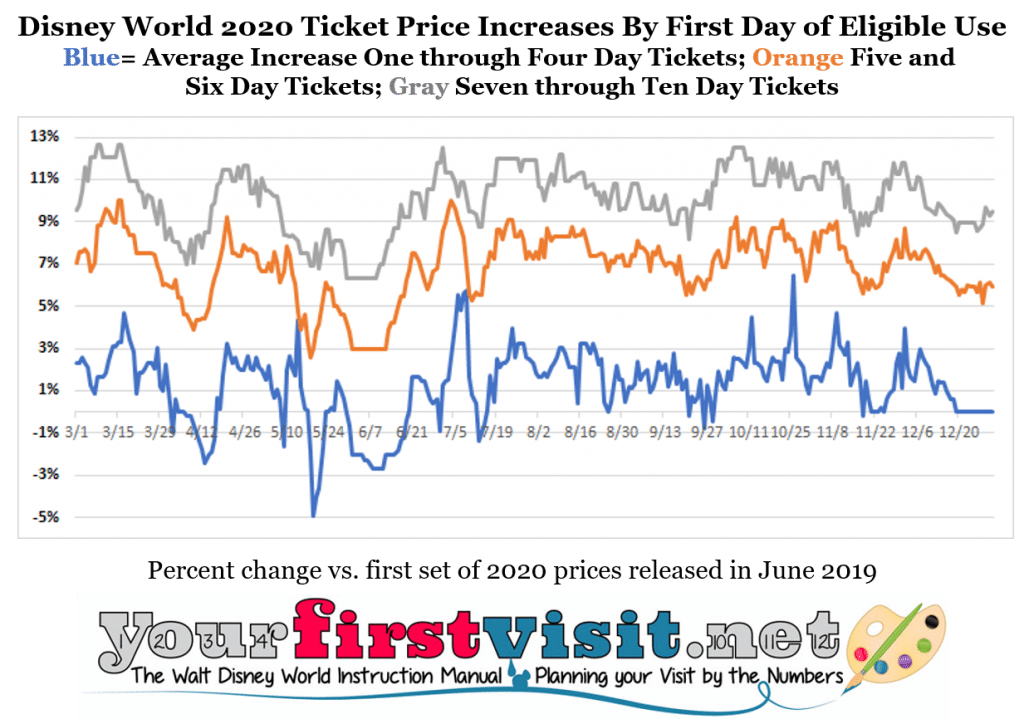Analysis of Disney World’s 2020 Ticket Price Increase
By Dave Shute
Earlier in February, Walt Disney World increased its ticket prices for 2020. Since then, I’ve spent most of my time on ticket prices getting my Disney World Tickets page and my color-coded Disney World ticket price calendar right.
In this post, I will be commenting on the level of increases, and also how they flow in the year.
2020 prices were first released in June 2019, and I always expected at least one more increase in 2020 prices—for two reasons.
- First, for years now, Disney World has increased prices for the current year in the late winter, typically February, and
- Second, the 2020 prices released in June of last year went up on average only about 2% compared to 2019 prices. Given recent patterns in price increases, there’s no way Disney World would have left this stand
2020 DISNEY WORLD TICKET PRICE INCREASES BY TICKET LENGTH
Base Disney World tickets can be bought for between one and ten days in the theme parks. With the February 2020 price increase, prices for longer tickets in 2020 increased substantially more than prices for shorter tickets. Shorter tickets went up on average less than 2%, while tickets seven days and longer went up 8.4% to 10.6%.
It’s easy to over-interpret this. For example, you could say that people wandering in for a quick sample of the new offerings in Galaxy’s Edge aren’t much penalized, but folks on a longer vacation trying to see all of Disney World bear an extra burden. This is absolutely true, but that does not mean it was Disney’s intent.
It was widely reported after the February ticket price increase that both the least and most expensive one day tickets did not change.
This is simultaneously true, trivial, and simple-minded. Hardly anyone buys one day tickets. What these tickets represent is the price anchor of longer tickets, whose prices are calculated as a proportion of the sum of the one day tickets covered by the usage period of the longer tickets.
What Disney essentially did for longer tickets was change the proportions used to calculate their prices. That let it get some positive PR from the simple-minded for not increasing the lowest and highest one day tickets–at which point the analytic savvy of most observers stopped–while also extracting substantially more value from folks committed to longer visits.
Two things remain generally true: because you are not penalized for adding days to a ticket (so long as you add such days before your last day of use) it never pays to overbuy your tickets. Buy the minimum ticket you think you night need, and only add more to it after you are in the parks and know you need your extra days.
Second, it remains true that the per day cost of longer tickets is almost always lower than that for shorter ones. So one longer visit is still largely much less expensive than two shorter visits.
Now let’s turn to how these price increases vary over the remainder of 2020.
2020 DISNEY WORLD TICKET PRICE INCREASES BY TICKET LENGTH AND DATE
This section includes two charts. The first one shows price increases by first day of eligible use for every ticket length—so it plots more than 3,000 percentage changes:
For many of you, there’s too much data plotted on the chart to see much information.
I tried to make up for this in the second chart, above, by grouping the average price increases of three sets of ticket lengths—one to four day tickets, which all saw less than 2% average increases; seven through ten day tickets, which all saw average increases of over 8%, and five and six day tickets, about in the middle of the other two.
One thing that distinctively stands out is that there is less variability in price changes after mid-July. Visually, this means that the ups and down of the price increases cover less of the vertical space of the chart. Analytically, the standard deviation of price increases, as a percentage of the mean, is twice as high before July 15 than it is after July 15.
There’s at least two possible explanation for why we see lower variance after July 15. One is that Disney–in its judgement–got relative prices among the dates after 7/15 closer to correct. The other is that Disney does not have enough information now to make fine grained adjustments later in 2020 the way it has done earlier in the year–you can see example of these finer grained adjustments in May, for example.
Since–despite the advice of folks like me–most Disney World trips are planned three months out or closer, my vote is for the second explanation. Note that this increases the odds of a second price increase, affecting these dates, perhaps in the summer when 2021 ticket prices are announced.
Remember that Disney’s date based ticket price model has two purposes.
- First, it intends to use prices to incent people towards dates less in demand, and away from dates higher in demand
- Second, it seeks to extract the extra value from high demand dates that’s on the table from those who go during high-demand periods anyway
Unless fine-grained visitation patterns are highly stable, these purposes present a strong case for multiple price changes over the course of the year, not the one (or rarely two) that we are used to at Walt Disney World.
Note that once you have bought your tickets, so long as you don’t make any later changes, you are free from the consequences of future price increases that would otherwise affect your dates.
The long-time travel agent partner of this site, Kelly, can set up your Disney World vacation for you, locking down your prices, including those of your park tickets. Contact her using the form below!
Analytic note. My percentage changes are based on comparing rounded per-day prices rather than complete-to-the-cents actual total prices—I do it this way because with more than 3,000 new prices to enter into my spreadsheet, it cuts data entry time by about 75%. This can add noise to the data at the level of 0.5% to 2% on any given data point, but the rounding errors it creates average out over the number of days I am looking at.
Follow yourfirstvisit.net on Facebook or Twitter or Pinterest!!








2 comments
Just want to say, I love your site for information like this. I find your website so useful & try to absorb all the information up like a sponge. I think I am getting pretty good at knowing how to pick parks for which days thanks to this site! 🙂
Thanks!!!
Leave a Comment | Ask a Question | Note a Problem